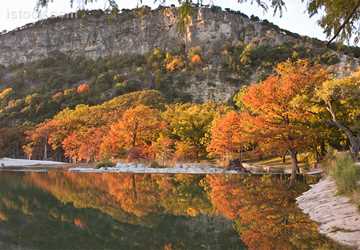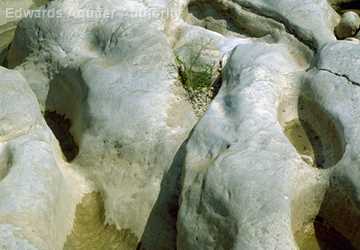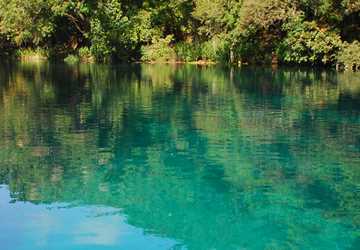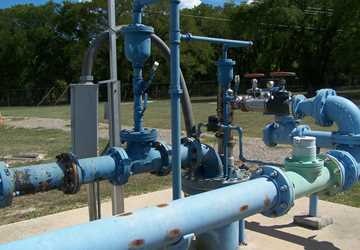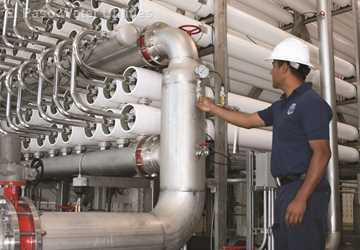Texas Comptroller Susan Combs is writing about it, the Texas Legislature’s Joint Interim Committee to Study Water Desalination is exploring it, and cities in the Rio Grande Valley, far West Texas and Central Texas are already using it.
As Texas’ population continues to multiply and with drought never far out of the picture, the use of brackish groundwater to meet future water supply needs is gaining interest in Texas water circles.
Within these aquifers are more than 880 trillion gallons of brackish groundwater. If converted to freshwater, that amount of water could maintain Texas’ current water consumption levels for about 150 years.
Brackish groundwater — or naturally occurring salty groundwater — is plentiful and widespread in Texas. “Almost every aquifer in the state has brackish groundwater, and there are 30 designated aquifers in the state,” said Dr. Sanjeev Kalaswad, team lead of innovative water technologies for the Texas Water Development Board (TWDB). Within these aquifers are more than 880 trillion gallons of brackish groundwater. If converted to freshwater, that amount of water could maintain Texas’ current water consumption levels for about 150 years, according to the Texas Comptroller’s Texas Water Report: Going Deeper for the Solution.
In the 2012 state water plan, five of the 16 regional water planning groups recommended groundwater desalination as one of their water management strategies to meet projected water needs in 2060. More planning regions are likely to recommend it for the 2017 plan.
To date, Texas has 34 municipal brackish groundwater desalination plants, providing about 73 million gallons of water a day. They range from small plants in the Rio Grande Valley to the largest inland desalination plant in the world — the Kay Bailey Hutchison Desalination Plant in El Paso.
El Paso’s is the most well-known desalination plant in Texas. It opened in 2007 and is managed by El Paso Water Utilities. The plant has the capacity to produce 27.5 million gallons of freshwater a day, increasing El Paso Water Utilities’ freshwater production by approximately 25 percent, according to the utility.
That is enough to meet the daily water needs of a community of 167,000 people.
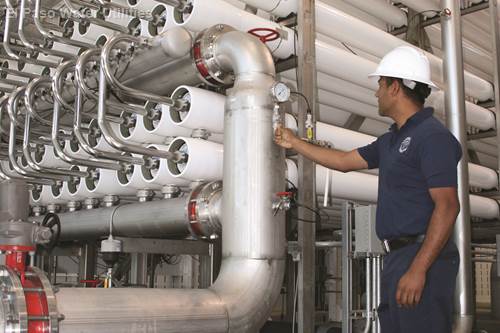
The San Antonio Water System (SAWS) is building a brackish groundwater desalination plant that will pump brackish water from the Wilcox Aquifer in southern Bexar County. The plant will draw brackish water from 13 production wells and, through the reverse osmosis process, produce about 10 million gallons of water a day when it comes online in 2016.
According to SAWS, the plant will expand in 2021 and 2026 to provide an additional 10 million gallons a day and 5 million gallons a day, respectively.
The unknowns of brackish groundwater
However, before water entities can use brackish groundwater more extensively in Texas, experts said additional understanding about this underground resource is needed.
Unknowns about brackish groundwater’s connection to fresh groundwater need further investigation. Extracting brackish water may affect the freshwater.
“We do know in a broad sense that we do have lots of brackish groundwater,” Kalaswad said, adding that the state is mapping the location of brackish aquifers and characterizing the depth, amount and quality of brackish groundwater through the Brackish Resources Aquifer Characterization System (BRACS). BRACS was established in 2009 with funding from the Texas Legislature.
The program’s first study was of the Pecos Valley Aquifer in West Texas, and it is currently studying the Gulf Coast Aquifer in the Rio Grande Valley and two other aquifers in south-central Texas. Kalaswad said TWDB eventually hopes to conduct BRACS for all Texas aquifers.
“It is very important to get a very good idea of the source material before we start to think about desalination,” he said.
Dr. Bridget Scanlon, senior research scientist for The University of Texas at Austin’s Bureau of Economic Geology, agreed that more specific knowledge is needed about brackish groundwater.
“For example, we don’t have a lot of data or geophysical logs for brackish [groundwater],” she said. “In some parts of Canada, they have policies requiring the oil companies to log from the land surface down, so that you have more information in that shallow zone, where you have brackish water.” Having that type of information would be beneficial in the United States, she said.
Unknowns about brackish groundwater’s connection to fresh groundwater need further investigation. Extracting brackish water may affect the freshwater, “which is definitely something to be concerned about,” Kalaswad said.
In some aquifers, such as the Carrizo-Wilcox, the brackish and freshwater can be separated by hundreds of feet of less permeable rocks such as siltstone and shale. In other aquifers, the two types of water are more closely connected and may form a continuum.
Scanlon explained that brackish extractions from aquifers with thick low-permeability zones separating freshwater from brackish water are less likely to impact freshwater. “But, if you have a dipping aquifer that dips down below the land surface toward the Gulf Coast, and the freshwater grades into brackish water as you go deeper, and they’re connected, then pumping brackish water would impact freshwater.”
As part of the BRACS program, Kalaswad said TWDB would like to conduct modeling to determine the effect of long-term pumping of brackish groundwater on freshwater aquifers and to determine if there is any potential for mixing of the two waters.
Cost plus technologies
Why aren’t more water providers and water planning groups jumping on the brackish groundwater bandwagon? The overwhelming answer, according to the experts, is cost.
“The first preference is always to get freshwater,” Kalaswad said. “It is a lot cheaper to treat freshwater than to treat brackish groundwater. It’s usually only when communities start to run out of freshwater that they start to look at brackish water.”
Dr. Bill Batchelor, professor and holder of the R. P. Gregory ’32 Chair in Texas A&M University’s Zachry Department of Civil Engineering, agreed that cost is a huge factor.
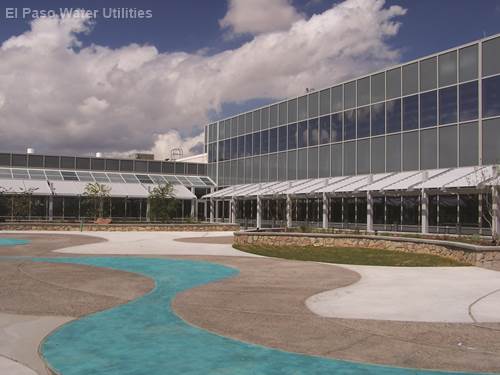
“Although costs have decreased a great deal over the past decades, desalination is still expensive compared to many alternatives such as conservation, reuse and developing new surface and groundwater supplies that do not require desalination,” Batchelor said.
In 2012, TWDB found the average cost to produce 1 acre-foot (about 326,000 gallons) of desalinated water from brackish groundwater ranged from approximately $357 to $782, or $1.25 to $2.60 for 1,000 gallons, which includes capital, operational and maintenance costs. The costs for El Paso Water Utilities to produce its desalinated water is 2.1 times more than its cost for fresh groundwater and 70 percent more than surface water, according to the utility.
Up to half of the cost is tied to the energy required for treatment. Kalaswad said 95 percent of the plants in Texas use an energy-intensive technology called reverse osmosis.
In reverse osmosis, the brackish water is pushed at high pressure through a semi-permeable membrane, causing freshwater to diffuse through the membrane and leaving behind the more salty water.
Driven by university and industry research, reverse osmosis technology has continually improved, making it more energy- and cost-efficient.
Hoping to save energy costs, Seminole, in West Texas, is testing using wind energy to operate its reverse osmosis desalination plant.
“Improvements in reverse osmosis membranes have resulted in much lower energy consumption and overall costs for reverse osmosis desalination,” Batchelor said. “The pace of improvements may slow, but I expect that they will continue.”
In addition to university research funded by other sources, TWDB has funded, with legislative appropriations, 12 brackish groundwater desalination demonstration projects, of which many dealt with reverse osmosis technology.
Hoping to save energy costs, Seminole, in West Texas, is testing using wind energy to operate its reverse osmosis desalination plant. Although the TWDB-funded project is not finished, Kalaswad said the results are promising, showing that wind energy could be a feasible alternative to traditionally generated energy.
Texas Sen. Craig Estes, chairman of the Joint Interim Committee to Study Water Desalination, sees promise in developing new technologies that will help reduce the costs.
“Advanced technologies have the potential to improve the cost-benefit analysis for communities with brackish water supplies,” he said, “but at the end of the day, we will not see a significant increase in the use of brackish water desalination until it becomes the least expensive solution.”
Kalaswad said TWDB worked with the Texas Commission on Environmental Quality (TCEQ) to determine if using computer models as surrogates for actual full-scale pilot studies of new reverse osmosis membrane types for brackish water is a valid option that could provide reliable results while saving significant money for water systems.
“Pilot demonstration studies are expensive and a burden on water providers,” he said.
According to Kalaswad and TCEQ, the models reliably predicted the performance of reverse osmosis membranes. “The use of computer models is a valid option for the water quality parameters that are defined in the models, and when evaluating more complex treatment schemes, such as various pretreatment and post-treatment options, are not required,” TCEQ experts wrote in an email.
This modeling is limited to water systems that don’t have any primary contaminant levels that exceed federally established health levels, according to TCEQ personnel. The model must demonstrate that the reverse osmosis membrane system will produce water that meets the target water quality goals and protects public health.
The TCEQ experts wrote that pilot demonstration studies may still be cost-effective for public water systems “if there are questions about the treatment technology or water sources.
“A pilot demonstration study allows the opportunity to test the efficacy of a treatment technology on a particular source [of] water. In some cases, results show that the treatment technology is not effective. In these situations, the study saved the public water system money that would have been wasted on a full-scale installation of the treatment technology and allowed for an alternate treatment technology to be selected.”
Disposal of the highly saline brine left over after the desalination process also adds to the costs, the experts said.
“The cost for disposing the produced brine can be a greater expense for inland desalination than for seawater desalination, where disposal offshore is usually the lower cost option,” Batchelor said.
Inland desalination plants dispose of their brine through deep well injection; discharge it to surface waters, a municipal sewer system, or an evaporation pond; or apply it onto land. TCEQ has different permits for each disposal method. To dispose of it by injection well, the plant must have a Class I well or Class V well permit, depending on the brine quality and water quality of the formation into which the waste is injected.
Kalaswad said it is expensive to install Class I injection wells for desalination concentrate disposal. A TWDB-funded feasibility study is looking at using existing Class II disposal wells permitted for oil and gas purposes for the concentrate.
Defining, regulating brackish groundwater
Another hurdle that must be addressed before brackish groundwater can be fully used, some believe, is the need to define and regulate it.
Experts said defining brackish groundwater might help better regulate it. No legal definition exists in Texas for brackish groundwater. Water is generally considered brackish if it contains total dissolved solids between 1,000 and 10,000 milligrams per liter. Some Texas Legislators introduced legislation in 2013 that would have defined brackish within those numbers, but it did not pass.
Groundwater conservation districts’ rules on pumping limits and exporting of water outside the district can have a big impact on a planned desalination project. In some instances, it has been a deal-breaker.
The same group of bills attempted to streamline the regulatory process for desalination and designate production zones for brackish groundwater. Currently, most groundwater conservation districts regulate and permit fresh groundwater and brackish groundwater the same.
“Groundwater conservation districts’ rules on pumping limits and exporting of water outside the district can have a big impact on a planned desalination project. In some instances, it has been a deal-breaker,” Kalaswad said.
Kalaswad referred to the recent decision by SAWS to reject three groundwater projects that would have piped groundwater from different areas in the state. One project could not guarantee that the water would be available in the future; the other two faced opposition from the district or citizens in the area.
“The goal of any legislation or regulation regarding groundwater should be to strike a balance between protecting our shared natural resources while also defending private property rights,” said Estes, who is also vice chairman of the Texas Senate Natural Resources Committee. “Both water and private property rights are essential to the continued success of Texas.”
Looking ahead: turning more research into new technologies
The Texas Comptroller’s recent report urged innovative new technologies for new water, including brackish groundwater. The report recommended increasing state funding for innovative demonstration projects and establishing a $25 million prize program to reward successful innovative technology achievements.
Between now and January 2015, when the Texas Legislature goes into session, the Texas Joint Interim Committee to Study Water Desalination is reviewing research from a variety of sources. The committee’s goal is to not only study desalination, but to also make recommendations to encourage the use of brackish water, Estes said.
Areas in which improved technologies are needed include better membranes that reduce their potential for fouling and increase the flow of water through them at a given pressure, and disposal of the dissolved salt concentrate.
Researchers are also developing alternative desalination methods such as the energy-efficient technologies of forward osmosis and capacitive desalination.
In forward osmosis, water flows across a selectively permeable membrane from naturally brackish water to salty water prepared with specific salts. Freshwater can then be removed from the salty water by applying heat, preferably from a source that is currently going to waste, such as a power plant’s cooling-water discharge. According to the Comptroller’s report, forward osmosis plants are already in place in countries such as Gibraltar and Oman in the Persian Gulf.
Capacitive desalination is a process in which charged molecules in the water — or ions — are removed by electrostatic attraction to a solid surface that has an electrical potential, Batchelor said. After the ions of sodium and chloride are removed from the water and the desalinated water is produced, the electrical potential is removed or reversed and the ions are released into a waste brine for disposal. Then the surface can be charged again to repeat the cycle.
As far as new technologies for brine disposal, Batchelor said zero-liquid discharge systems offer promise for extending the range of places where desalination can be used and reducing the impacts of brine disposal, a major limitation for inland desalination.
“To achieve zero-liquid discharge, the flow of waste brine must be reduced. This can be achieved by using a number of reverse osmosis stages,” he said, adding that improvements in these stages could facilitate the acceptance of zero-liquid discharge.
“Energy recovery systems and use of alternative energy sources such as wind energy are additional areas in which improvements should be seen,” Batchelor said.
For example, forward osmosis can use waste heat. “The overall energy needs are not necessarily lower, but using energy that would otherwise be wasted is attractive,” Batchelor said.
“I think we will be doing more and more research in brackish [groundwater],” Scanlon said. “It’s very important. With projected increases in hydraulic fracturing in the Permian Basin and the Eagle Ford Shale, brackish water resources could be important resources for [that area]. I think they will be looking at that more and more.”
Kalaswad also believes the state will increasingly use brackish groundwater for future water supplies, even more than the projected 2 percent of total water supplies predicted in 2060 if the state continues experiencing drought. “The technology is there; it’s just a matter of availability of the resource and how much people are willing to pay for water.”
Explore this Issue
Authors
As the former communications manager for TWRI, Kathy Wythe provided leadership for the institute's communications, including a magazine, newsletters, brochures, social media, media relations and special projects.


